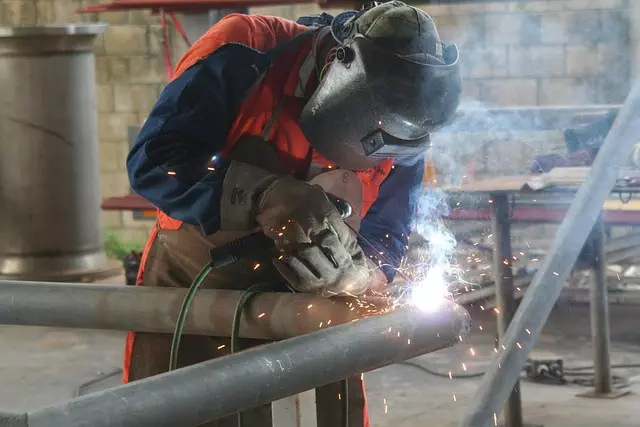Healthcare organizations prioritize worker safety through industrial hygiene, focusing on hazard recognition, assessment, and exposure monitoring. This process involves identifying risks like chemical exposures and infectious agents, assessing their severity, and implementing data-driven control measures. Effective strategies include engineering controls, PPE, and regular training, fostering a culture of safety that protects workers and enhances patient care by creating safer work environments. Continuous exposure monitoring through advanced technologies ensures compliance with safety standards, enabling healthcare facilities to make informed adjustments to protection protocols.
In the frontline of patient care, healthcare workers (HCWs) face unique challenges posed by diverse hazards in their work environments. This article delves into the critical aspect of worker protection through a multifaceted approach. We explore industrial hygiene in healthcare settings, emphasizing hazard recognition and assessment as foundational steps. The role of exposure monitoring is scrutinized for its capability to guide protective strategies. We present effective minimization techniques and highlight successful case studies, offering practical insights for enhancing safety in these essential workplaces.
- Understanding Industrial Hygiene in Healthcare Settings
- Identifying and Assessing Hazards Among Healthcare Workers
- The Role of Exposure Monitoring in Worker Protection
- Strategies for Minimizing Risks and Enhancing Safety
- Case Studies: Successful Implementation of Protective Measures
Understanding Industrial Hygiene in Healthcare Settings
In healthcare settings, ensuring the safety and well-being of workers is paramount. Industrial hygiene plays a crucial role in achieving this by focusing on the prevention of work-related illnesses and injuries. It involves a comprehensive understanding of potential hazards present in these environments, ranging from chemical exposures to ergonomic risks. By practicing industrial hygiene, healthcare facilities can effectively recognize and assess various hazards, implementing targeted strategies for mitigation.
One key aspect is exposure monitoring, where professionals measure and evaluate workers’ exposure to harmful substances or conditions. This data-driven approach allows for the development of control measures, ensuring that exposure levels remain below established safety thresholds. Through diligent hazard recognition and assessment, healthcare organizations can create safer work environments, protect their employees, and ultimately improve patient care.
Identifying and Assessing Hazards Among Healthcare Workers
Identifying and assessing hazards among healthcare workers is a crucial step in ensuring their safety and well-being. Industrial hygiene plays a pivotal role in this process by focusing on preventing work-related illnesses and injuries. The first step involves thorough hazard recognition, where potential risks specific to healthcare settings are identified. These can range from biological agents like pathogens and bacteria to chemical substances used for cleaning and sterilization, physical hazards like noise and radiation, and ergonomic issues related to repetitive tasks. Once these hazards are recognized, a systematic assessment process begins. This includes evaluating the severity and likelihood of exposure, as well as the potential health impacts. Exposure monitoring is an essential tool in this assessment, helping to measure and quantify workers’ actual exposure levels.
By combining hazard recognition and assessment with effective exposure monitoring, healthcare organizations can implement targeted strategies to minimize risks. This proactive approach not only protects workers but also contributes to improved patient outcomes by creating a safer healthcare environment.
The Role of Exposure Monitoring in Worker Protection
Exposure monitoring is a cornerstone of healthcare worker protection, playing a pivotal role in ensuring their safety and well-being within the workplace. This process involves systematic measurements and assessments to identify and quantify potential hazards to which workers may be exposed. By implementing comprehensive exposure monitoring programs, organizations can actively manage risks associated with various occupational settings, including medical facilities.
The practice leverages advanced technologies and methods such as air sampling, biological indicators, and personal protective equipment (PPE) fit testing. These tools enable professionals in industrial hygiene to recognize and assess hazards like chemical fumes, infectious agents, or ergonomic stressors. Through continuous monitoring, they can track exposure levels over time, ensuring compliance with safety standards and regulatory guidelines. This proactive approach not only helps prevent work-related illnesses but also fosters a culture of safety by empowering healthcare workers to take an active role in their protection.
Strategies for Minimizing Risks and Enhancing Safety
Minimizing risks and enhancing safety for healthcare workers involves a multi-faceted approach. First, implementing robust industrial hygiene practices is essential. This includes identifying potential hazards in the work environment—such as infectious agents, chemical substances, or ergonomic stressors—and assessing their magnitude and likelihood to cause harm. Regular exposure monitoring is crucial to quantify worker exposure levels and ensure compliance with safety standards and regulations.
Once hazards are recognized and assessed, targeted interventions can be put in place. These may include engineering controls (like improved ventilation systems), administrative controls (e.g., standard operating procedures for infection control), or personal protective equipment (PPE). Regular training and education sessions help healthcare workers understand these measures, fostering a culture of safety that is paramount to protecting them from workplace hazards.
Case Studies: Successful Implementation of Protective Measures
The successful protection of healthcare workers begins with thorough case studies that highlight effective implementation strategies. These studies show that integrating industrial hygiene practices and hazard recognition/assessment processes is key to creating safer environments. By identifying potential risks, such as infectious diseases or chemical exposures, facilities can take proactive measures. For example, implementing engineering controls like improved ventilation systems or using personal protective equipment (PPE) specifically designed for the task at hand significantly reduces exposure.
Additionally, exposure monitoring plays a pivotal role in ensuring worker safety. Regular testing and assessment allow healthcare institutions to verify the effectiveness of implemented safeguards. This data-driven approach enables them to make informed adjustments when necessary, continually enhancing protection protocols. Case studies demonstrate that combining these practices results in better outcomes for both workers and patients, underscoring their critical importance in modern healthcare settings.


